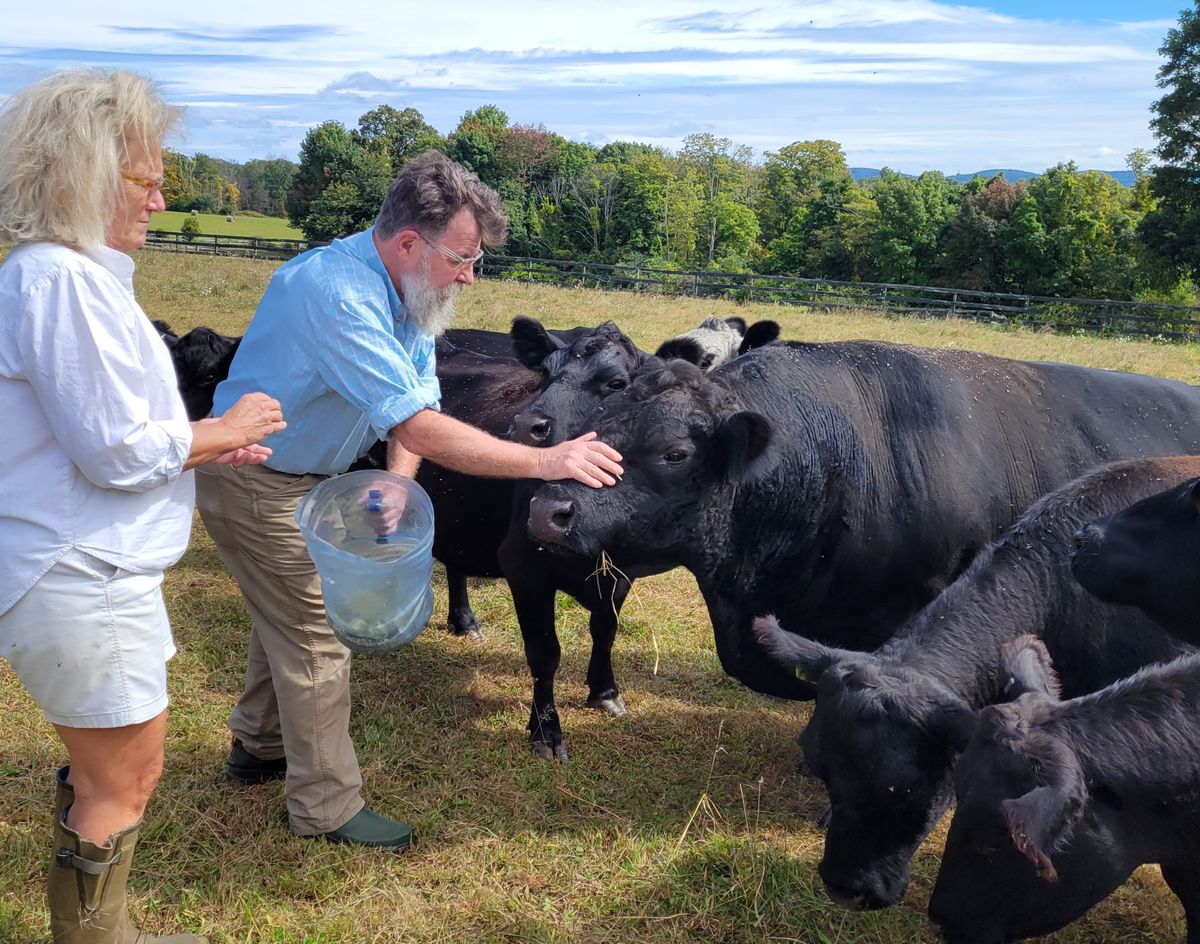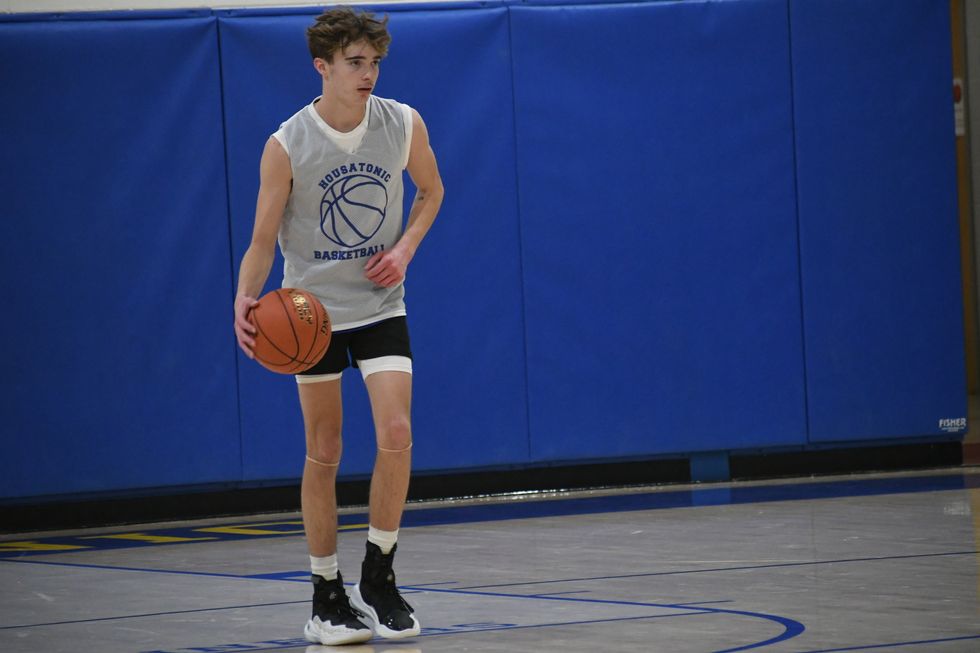Land Conservancy disburses thousands in climate grants

James and Katherine Shepherd tend to their American Aberdeen cattle at Smokedown Farm in Sharon.
Debra A. Aleksinas

James and Katherine Shepherd tend to their American Aberdeen cattle at Smokedown Farm in Sharon.
“We will use the animals to do weed control and pruning and soil improvements with reduced chemical input.”
Dr. James Shepherd, owner of Smokedown Farm in Sharon
SHARON — Four working farms in the Northwest Corner are among the Northwest Connecticut Land Conservancy’s (NCLC) first round of eight grantees receiving a total of $114,000 for the adoption of climate-smart agricultural practices.
Among the grantees are Smokedown Farm in Sharon ($30,000); Beavertides Farm in Falls Village ($17,000); Northwest Corner Farm in Winchester ($14,000) and Canaan View Dairy/CowPots in East Canaan ($5,000).
NCLC’s Building Resiliency Program is made possible through a grant from the Connecticut Department of Agriculture’s Climate-Smart Agriculture and Forestry (CSAF) program.
“NCLC seeks to ensure that as many working farms as possible benefit from this funding,” made possible through two rounds of grants, the second round slated for Oct. 1 through Nov. 20, according to Amanda Branson, NCLC’s Director of Operations & Finance.
Rotational grazing of livestock
During a visit to Smokedown Farm last week, Dr. James Shepherd, who runs the 175-acre family-owned farm with his wife, Katherine, explained that the $30,000 grant will be used to purchase fencing to enhance rotational grazing of sheep and American Aberdeen cattle around the farm’s 9 acre hopyard and additional pastures.
“Part of this climate resiliency grant is auspiciously for rotational grazing,” by adding more fields to the pasture and bringing the farm’s 9-acre hopyard into the rotation, he said. “Then we will use the animals to do weed control and pruning and soil improvements with reduced chemical input.”
As he spoke, hoofbeats and clouds of dust grew closer as the farm’s 200 stampeding sheep, including 100 ewes, were led from one field to another by Pippa, an energetic year-and-a half-old Border Collie.
Reducing Greenhouse gas emissions
The Freund family farm’s Canaan View Dairy/CowPots operation received $5,000 to conduct a feasibility study, the first step in receiving funding for a new anaerobic digester to replace its antiquated machinery.
Anaerobic digesters reduce greenhouse gas emissions by capturing methane from livestock waste. They provide a renewable energy source that can decrease the farm’s reliance on fossil fuels and lower operational costs.
“Our anaerobic methane digester was installed in 1997. It is the longest continuously operating digester in the country,” said Amanda Freund, who oversees the CowPots facility. “After 27 years, the costs, time and skills needed to keep it in operation are extensive.”
She explained that the planned site for a new digester would also make it possible to deliver the heat energy to the CowPots operation’s ovens to dry their finished product.
“We designed our factory to have zero waste stream. This project would allow us to further close the loop so that the energy required for heat and drying would be provided by the cow manure, reducing our reliance on fossil fuels.”
Support for a silvopasture, windbreak
Falls Village’s Beavertides Farm was granted $17,000 to develop a silvopasture through the purchase of tree seedlings and establishment materials, and to enhance rotational grazing of their sheep and beef cows through fencing.
The integration of forestry and rotational grazing enhances biodiversity and allows pastures to sequester more carbon. Silvopasture also improves livestock health through protection from extreme weather patterns.
Northwest Corner Farm in Winchester will receive $14,000 to establish a windbreak to protect the hilltop farm, and develop and expand pollinator habitat. The plantings reduce erosion, enhance soil health and provide food and shelter for wildlife and pollinators.
The Salisbury Winter Sports Association (SWSA) will host its annual Junior Jump Camp, a two-day introduction to ski jumping, on Saturday and Sunday, Dec. 27 and 28, from 9 a.m. to 2 p.m. at Satre Hill in Salisbury.
The camp is open to children ages 7 and up and focuses on teaching the basics of ski jumping, with an emphasis on safety, balance and control, using SWSA’s smallest hill. No prior experience is required.
The cost is $50 per child and includes instruction and lunch on both days. For more information or to register, visit www.skireg.com/swsa-camp or email info@jumpfest.org
Jesse Bunce, first selectman of North Canaan.
LITCHFIELD — The Northwest Hills Council of Governments welcomed six newly elected municipal leaders Thursday, Dec. 11, at its first meeting following the 2025 municipal elections.
The council — a regional planning body representing 21 towns in northwest Connecticut — coordinates transportation, emergency planning, housing, economic development and other shared municipal services.
Barkhamsted First Selectman Meaghan Cook, Goshen First Selectman Seth Breakell, Kent First Selectman Eric Epstein, Norfolk First Selectman Henry Tirrell, North Canaan First Selectman Jesse Bunce and Torrington Mayor Molly Spino were each elected to their post in November.
They filled the seats of their predecessors on the COG, who were each given a toast of appreciation: Nick Lukiwsky (Barkhamsted), Todd Carusillo (Goshen), Marty Lindenmeyer (Kent), Matt Riiska (Norfolk), Brian Ohler (North Canaan) and Elinor Carbone (Torrington).
COG Executive Director Rob Phillips said the outgoing members were given a going away mug that read “You’re living the dream still.” Members voted to appoint Warren First Selectman Greg LaCava to fill a vacancy on the Council’s Executive Committee. COG members voted by paper ballot, and LaCava defeated Burlington First Selectman Doug Thompson for the vacant seat.
Ryan Segalla takes a fadeaway shot over a defender.
FALLS VILLAGE — Housatonic Valley Regional High School’s boys basketball team defeated Pine Plains High School 60-22 in a scrimmage Tuesday, Dec. 9. The non-league preseason game gave both sides an opportunity to run the court ahead of the 2025-26 varsity season.
HVRHS’s senior-heavy roster played with power and poise. The boys pulled ahead early and kept their foot on the gas through to the end.
By halftime the score was 33-8. Junior varsity players subbed in for the second half, but not before the starters got some in-game dunk practice. By the end Housatonic totaled 60 points to Pine Plains’ 22.

Nick Crodelle led the Mountaineers offensively with 13 points. Anthony Labbadia and Wyatt Bayer scored nine points each. Anthony Foley scored eight points. Owen Riemer and Ryan Segalla each scored seven points. Peyton Bushnell hit a three-pointer. Jaxon Visockis and Henry Berry each scored two points.
HVRHS begins Berkshire League competition on the road at Nonnewaug High School Tuesday, Dec. 16, with a 6 p.m. tip off.


Katie Moore delivers toys to the Stuff a Truck campaign held by the Kent Volunteer Fire Department last weekend. Donated toys are collected so that parents, who need some assistance, may provide their children with gifts this Christmas. Accepting the donation are elves Fran Goodsell and Karen Iannucci
KENT — Santa’s elves were toasty warm as they collected toys for the children of Kent.
Keeping with annual tradition, Fran Goodsell and Karen Iannucci manned the Stuff a Truck campaign sponsored by the Kent Volunteer Fire Department on Saturday, Dec. 6, and Sunday, Dec. 7. Sitting in front of a fire pit in the firehouse parking lot between donations from residents, they spoke of the incredible generosity displayed every season. That spirit of giving was clear from the piles of toys heaped on a table.
“This is always so gratifying,” said Goodsell, noting that certain businesses, including High Watch Recovery Center, Wilson’s, and Kent and South Kent schools needed a “shout out” for all they’ve done. She said South Kent School focuses on gifts for older children, which is a group that often is overlooked.
Unwrapped contributions are sought for children 1 to 15 years old who might otherwise find little or nothing from Santa, they said. The bounty will be set up at the Community House on Thursday, allowing parents to come and take what they want. If there are still items left, grandparents are invited to “shop.”
The atmosphere was festive Saturday, as a stuffed dog began barking a Christmas tune whenever someone walked in front of it. A large decked-out bear posted at the parking lot entrance reminded passersby of the event. Visiting children were able to get a close-up look at the fire truck and walk through the firehouse if they wished.
Goodsell and Iannucci were very grateful to those who donated wood for the fire pit. “And so many asked if they could bring us coffee or hot chocolate,” said Iannucci.
Goodsell said many who came talked about having grown children who were recipients of the gifts when their families were struggling. “They are so glad to be able to give back,” she said.